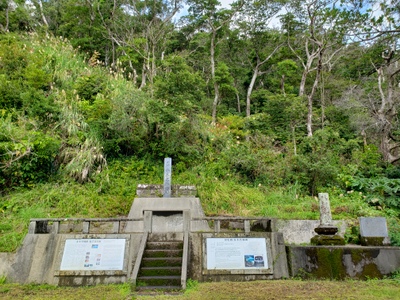Difference between revisions of "Akakina gusuku"
| Line 3: | Line 3: | ||
Akakina gusuku was a ''[[gusuku]]'' site located on [[Amami Oshima|Amami Ôshima]] (in what is today Kasari Town). In the [[Edo period]], a ''daikansho'' (''[[daikan]]'' official's office) and the Buddhist temple Akakina Kannon-ji were established on the site; a branch of the [[Shinto shrine]] [[Akiba Shrine]] is located on the site today. | Akakina gusuku was a ''[[gusuku]]'' site located on [[Amami Oshima|Amami Ôshima]] (in what is today Kasari Town). In the [[Edo period]], a ''daikansho'' (''[[daikan]]'' official's office) and the Buddhist temple Akakina Kannon-ji were established on the site; a branch of the [[Shinto shrine]] [[Akiba Shrine]] is located on the site today. | ||
| + | |||
| + | The ''gusuku'' is considered representative of medieval ''gusuku'' sites in the [[Amami Islands]]; located on a hill overlooking Kasari Bay, it featured stone walls of a style reflecting stronger Japanese than Ryukyuan influence. | ||
The local ''daikan'' was based for a time at Akakina; his office (the ''daikansho'') was relocated in [[1801]] to Itsubu village or Kaneku village (in what is today Naze City), but the Kannon-ji temple remained for nearly another twenty years, before being relocated to Itsubu as well in [[1819]]. | The local ''daikan'' was based for a time at Akakina; his office (the ''daikansho'') was relocated in [[1801]] to Itsubu village or Kaneku village (in what is today Naze City), but the Kannon-ji temple remained for nearly another twenty years, before being relocated to Itsubu as well in [[1819]]. | ||
| − | The Kasari Town government officially named the site a "cultural property" (町指定文化財, ''machi shitei bunkazai'') in 1971. | + | The Kasari Town government officially named the site a "cultural property" (町指定文化財, ''machi shitei bunkazai'') in 1971. It was then nationally-designated as a "historical site" (国史跡, ''kuni shiseki'') in 2008. |
==Akakina Kannon-ji== | ==Akakina Kannon-ji== | ||
| Line 16: | Line 18: | ||
==References== | ==References== | ||
| − | *Explanatory plaques on-site.[https://www.flickr.com/photos/toranosuke/49491196927/sizes/h/] | + | *Explanatory plaques on-site.[https://www.flickr.com/photos/toranosuke/49490984216/sizes/h/][https://www.flickr.com/photos/toranosuke/49491196927/sizes/h/] |
<references/> | <references/> | ||
Revision as of 06:30, 10 August 2021
- Japanese: 赤木名城 (Akakina gusuku)
Akakina gusuku was a gusuku site located on Amami Ôshima (in what is today Kasari Town). In the Edo period, a daikansho (daikan official's office) and the Buddhist temple Akakina Kannon-ji were established on the site; a branch of the Shinto shrine Akiba Shrine is located on the site today.
The gusuku is considered representative of medieval gusuku sites in the Amami Islands; located on a hill overlooking Kasari Bay, it featured stone walls of a style reflecting stronger Japanese than Ryukyuan influence.
The local daikan was based for a time at Akakina; his office (the daikansho) was relocated in 1801 to Itsubu village or Kaneku village (in what is today Naze City), but the Kannon-ji temple remained for nearly another twenty years, before being relocated to Itsubu as well in 1819.
The Kasari Town government officially named the site a "cultural property" (町指定文化財, machi shitei bunkazai) in 1971. It was then nationally-designated as a "historical site" (国史跡, kuni shiseki) in 2008.
Akakina Kannon-ji
Akakina Kannon-ji was a branch temple of Fukushô-ji, the main bodaiji (family temple) of the Shimazu clan in the castle-town of Kagoshima (on the Kyushu "mainland"). Established in 1675, it remained on the former site of Akakina gusuku until 1819. During that time, Kagoshima domain officials frequently prayed at the site for safe sea travel, or for reassurance or peace of mind more generally.
The temple, dedicated to the bodhisattva Kannon, is said to have had a notable influence in introducing Buddhist practices such as the burning of incense, the saying of certain Buddhist prayers or phrases, and Buddhist funerary practices to the local islanders. Local songs (shima uta) and summer dances (hachigatsu odori) developed around the temple as well.
The temple was dismantled in the shinbutsu bunri (separation of Shinto and Buddhism) efforts of the early Meiji period. Stone statues of a seated Kannon and of the goddess Benzaiten held today at Ôkuma Ryûô Shrine (in Naze City) are believed to have come from the temple.
